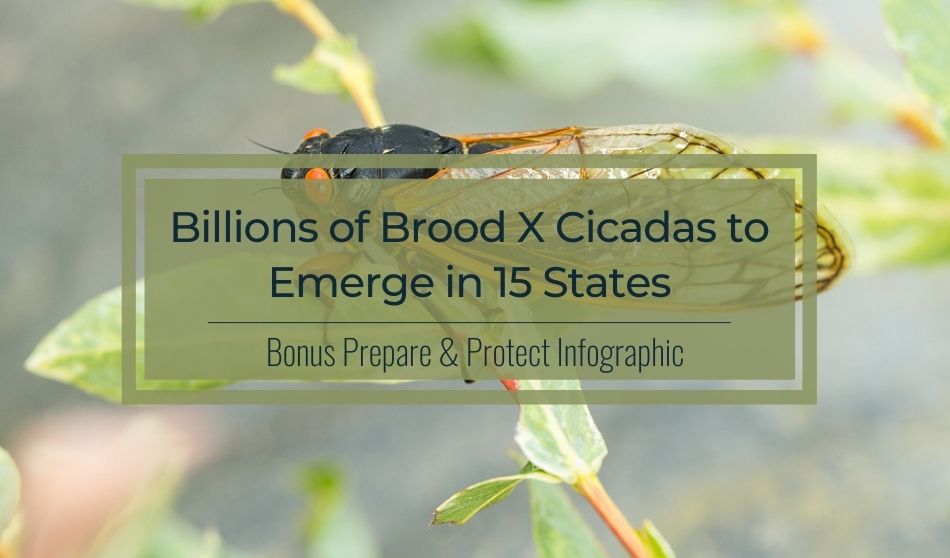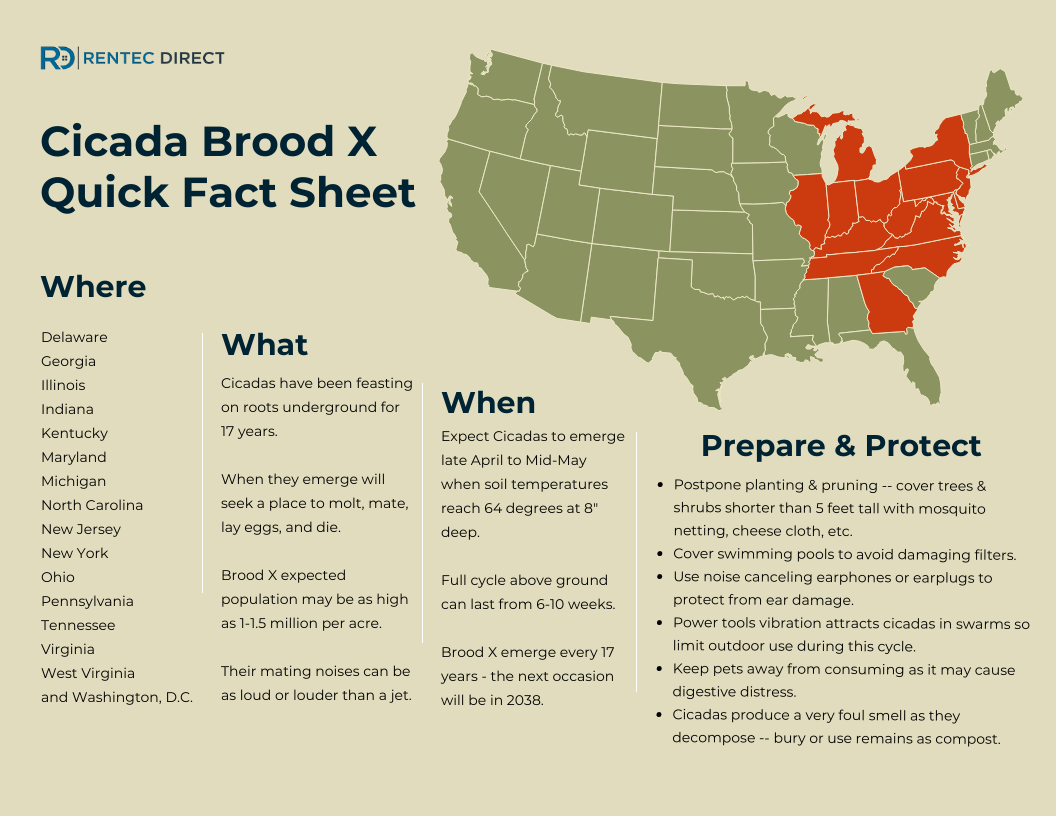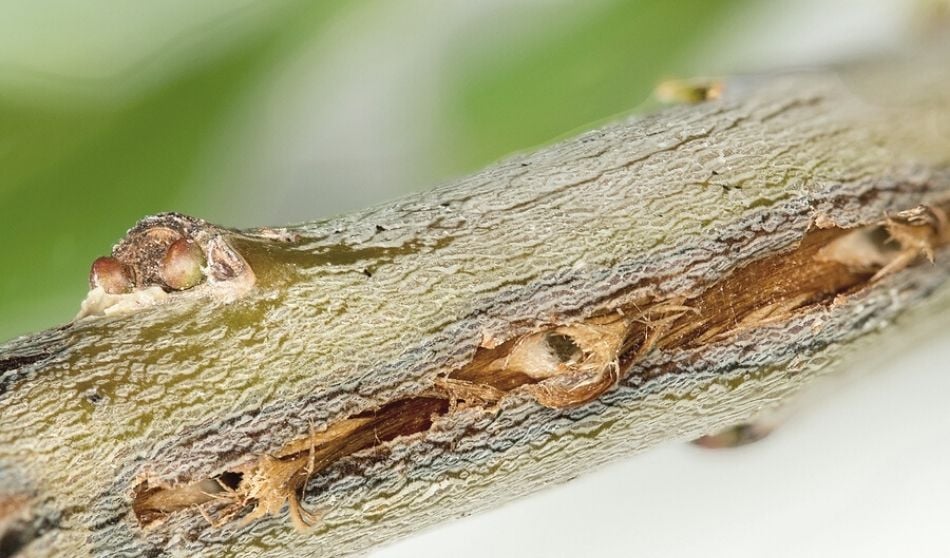
Although relatively harmless, the sheer number of cicadas to emerge en masse across 15 states will certainly require some preparation for homeowners and landlords
Many locations across the country experience an annual cicadas season but the coming phenomenon is a rare occurrence and the sheer number of cicada will pose some unique challenges.
To help prepare for the event, we will dive into the details on what to expect and some useful suggestions. As an overview, this handy fact sheet infographic gives you the basics but read further for additional information and tips.

Download the printable .pdf here: Cicada Brood X Quick Fact Sheet Prepare and Protect Infographic
One – What are Cicadas
In certain regions of the country, you’d hear them nicknamed ‘cicada bug’ as these insects have beetle-like features.
There are two main types: annual cicadas and periodical cicada. Annual cicada are green in color, show themselves yearly, and come in small clusters that rarely cause concern. Periodical cicada tends to be black and brown in color and emerge in series of years en masse that may require a preparation to contend with their actions and sheer quantity.
These periodical groups are called broods, cataloged by Roman-numeral. Pending arrival, this 17 year cicada brood labeled Brood X will show in numbers in biblical proportions this spring.
Though great in number, they cause comparatively little damage overall. Locust vs cicada, hands-down, locusts will win the honors for most destruction. Unlike a locust, cicadas do not munch on foliage but rather survive off the liquid and sap from trees and plant roots.
Two – When and Where to Expect the Brood X Cicada Experience
Brood X Cicadas will show in force across these 15 states:
Delaware
Georgia
Illinois
Indiana
Kentucky
Maryland
Michigan
North Carolina
New Jersey
New York
Ohio
Pennsylvania
Tennessee
Virginia
West Virginia
— and also in the District of Columbia (Washington D.C.)
They are set to arrive in late April to mid-May depending on suitable weather conditions. Expect to see them when soil temperatures reach 64 degrees Fahrenheit at a depth of 8 inches.
Three – What to Expect From This Rare Cicada Life Cycle
When the temperature is just right, these 17 year cicada will crawl their way out of the ground and search for the nearest vertical surface to climb; mostly trees, posts, or tall shrubs.
From there, these mature cicada nymphs begin to molt; shedding their exoskeleton which takes about 5-6 days. Once they drop their cicada shell, they start the mating process.
The cicada sound comes from the drum-like organ called a tymbal the males use to attract the females. This cicada noise can be deafening. To compare, a jet’s reverberation can be more than 80 decibels, but cicada noise has been tracked at over 100 decibels.
Females have a blade-like organ called an ovipositor used to cut trenches into branches where they lay their eggs. They create up to 20 of these trenches and can lay up to 600 eggs each.
In 4-6 weeks the eggs will hatch and those nymphs will drop to the ground and burrow to feed on the sap of roots until it’s time to reemerge. The next occurrence will be in the year 2038.

Female cicada can cause damage to limbs, tree branches, and shrubs by making these types of trenches in preparation for laying eggs.
Four – How to Prepare and Protect Your Properties and Tenants
Because Brood X’s predicted population is 1-1.5 million per acre, this can quickly become overwhelming. The three biggest challenges will be dealing with the noise volume, protecting trees and shrubs, and disposing of their remains.
Setting tenant expectations is important. They may be new to the area or young enough not to remember the last cycle. Add a note to a tenant newsletter or send an email to communicate this upcoming event. Here are some important tips for you and your tenants:
- Protect your ears — Prepare for the loud buzzing and consider wearing earplugs or noise-canceling earphones.
- Handle with care — If you find them indoors, remember that they are there accidentally and are not harmful. Although they don’t bite, don’t attempt to handle them without gloves as they may inadvertently mistake a hand or finger as a tasty tree limb. Note, the males have a defensive buzz if handled which can be startling.
- Avoid creating a swarm — Limit the use of power equipment such as lawn trimmers, leaf blowers, mowers, and power tools until after this cycle is over. The vibration from the equipment can confuse the males into thinking they have located interested females; creating a swarm.
- Postpone planting and pruning — Set those tasks aside until after June if possible. Cover trees, limbs, and shrubs shorter than 5 feet with cheese cloth, mosquito netting, or other fine mesh coverings. Trees over 5 feet may experience some damage but likely will survive.
- Cover outdoor water features — Cover swimming pools or clean pool skimmers and filters frequently to keep them from getting clogged. Cover ornamental ponds as decomposing cicadas can deplete the oxygen in the water.
- Keep an eye on pets — Although they are edible (many recipes online) watch over pets as eating the exoskeleton in bulk can cause digestive distress and swallowing them whole is a choking hazard.
- Outdoor alternatives — Avoid strolling under a tree during this time and consider scheduling outdoor activities like weddings until after June.
- Remove the remains — Because they migrate in swarms, there will be an enormous amount of both exoskeletons and dead cicada to discard. If left unattended the rotting skink will be overwhelming. Rakes, shovels, and a broom should do the trick. It’s best to compost or bury the remains.
Brood X, along with other periodical and annual cicadas are virtually harmless to people, pets, and the environment. In fact, The National Wildlife Federation notes that cicadas are mostly beneficial as they prune trees, aerate the soil, and once they die, their bodies serve as an important source of nitrogen for growing trees.





